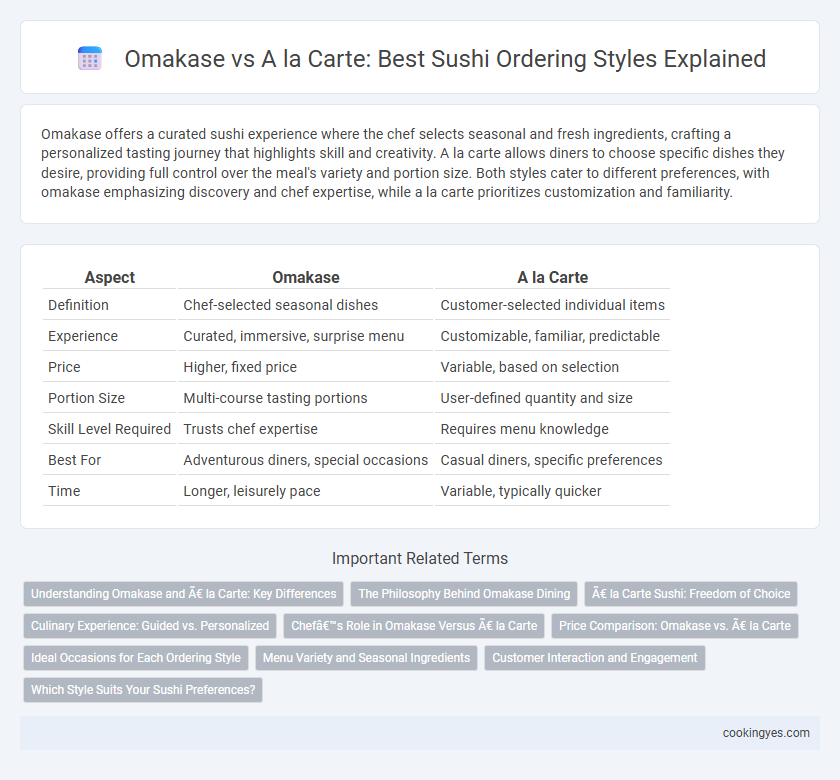Omakase offers a curated sushi experience where the chef selects seasonal and fresh ingredients, crafting a personalized tasting journey that highlights skill and creativity. A la carte allows diners to choose specific dishes they desire, providing full control over the meal's variety and portion size. Both styles cater to different preferences, with omakase emphasizing discovery and chef expertise, while a la carte prioritizes customization and familiarity.
Table of Comparison
| Aspect | Omakase | A la Carte |
|---|---|---|
| Definition | Chef-selected seasonal dishes | Customer-selected individual items |
| Experience | Curated, immersive, surprise menu | Customizable, familiar, predictable |
| Price | Higher, fixed price | Variable, based on selection |
| Portion Size | Multi-course tasting portions | User-defined quantity and size |
| Skill Level Required | Trusts chef expertise | Requires menu knowledge |
| Best For | Adventurous diners, special occasions | Casual diners, specific preferences |
| Time | Longer, leisurely pace | Variable, typically quicker |
Understanding Omakase and À la Carte: Key Differences
Omakase is a Japanese dining style where chefs select and serve seasonal sushi dishes, offering a curated experience that highlights fresh and premium ingredients. A la carte allows diners to choose individual sushi pieces or rolls, providing flexibility and control over the meal but relying on personal preference rather than the chef's expertise. Understanding these key differences helps sushi enthusiasts decide between an immersive, chef-driven tasting or a customizable, personalized order.
The Philosophy Behind Omakase Dining
Omakase dining embodies the philosophy of trust and culinary artistry, where the chef selects dishes based on seasonality, freshness, and creativity, creating a personalized experience that highlights the chef's expertise. Unlike a la carte ordering, which allows diners to choose specific items from the menu, omakase emphasizes an evolving tasting journey designed to showcase the harmony of flavors and textures in sushi-making. This approach deepens the connection between chef and guest, transforming the meal into an immersive event that celebrates traditional techniques and premium ingredients.
À la Carte Sushi: Freedom of Choice
A la carte sushi offers diners complete freedom of choice, allowing them to select specific pieces based on personal taste and dietary preferences. This ordering style provides flexibility to customize the meal experience, from the types of fish to portion sizes, enhancing satisfaction for sushi enthusiasts. Unlike omakase, a la carte accommodates individual cravings and budget considerations, making it a popular option in sushi restaurants worldwide.
Culinary Experience: Guided vs. Personalized
Omakase offers a guided culinary experience where the chef selects seasonal and fresh ingredients to create a harmonious tasting journey, highlighting the chef's expertise and creativity. A la carte allows diners to personalize their meal by choosing specific dishes, catering to individual preferences and dietary needs for a more tailored dining experience. Both styles emphasize different aspects of sushi enjoyment, with Omakase focusing on surprise and craftsmanship, while A la carte prioritizes customization and control.
Chef’s Role in Omakase Versus À la Carte
In Omakase dining, the chef curates a personalized tasting experience, selecting seasonal and premium ingredients to showcase culinary expertise and creativity. This style relies heavily on the chef's intuition and skill to balance flavors and textures, offering a dynamic and often exclusive meal. Conversely, A la carte ordering empowers diners to choose specific dishes from the menu, giving the chef a more structured role focused on consistent preparation rather than spontaneous creation.
Price Comparison: Omakase vs. À la Carte
Omakase dining typically commands higher prices due to its curated multi-course experience crafted by the chef, offering premium, seasonal ingredients and expert presentation. A la carte ordering allows customers to select individual sushi pieces or dishes, often resulting in more flexible and potentially lower overall costs based on personal preferences. Price differences reflect the level of customization, ingredient quality, and dining experience unique to each style in sushi restaurants.
Ideal Occasions for Each Ordering Style
Omakase is ideal for special occasions and sushi enthusiasts seeking a curated, chef-driven experience that highlights seasonal and premium ingredients. A la carte suits casual dining or those who prefer customized selections, offering flexibility to explore individual preferences and portion control. Both styles cater to different dining moods, with Omakase emphasizing discovery and A la carte prioritizing choice.
Menu Variety and Seasonal Ingredients
Omakase offers a curated dining experience featuring seasonal ingredients selected by the chef, ensuring a unique and fresh menu that changes regularly. A la carte allows diners to choose from a wide variety of sushi types and accompaniments, providing greater control over meal composition but often with less emphasis on seasonality. Both styles highlight premium ingredients, but Omakase emphasizes chef creativity and seasonal variety, while A la carte prioritizes menu flexibility.
Customer Interaction and Engagement
Omakase ordering fosters a personalized dining experience by allowing chefs to craft a tailored menu based on customer preferences and seasonal ingredients, enhancing engagement through direct chef-customer interaction. A la carte offers diners control over specific dish choices, promoting a more independent yet flexible engagement style where customers select favorites at their own pace. Both styles emphasize distinct levels of interaction, with Omakase creating an immersive, narrative-driven experience and A la carte providing convenience and customization.
Which Style Suits Your Sushi Preferences?
Omakase offers a curated sushi experience where the chef selects seasonal and premium ingredients, perfect for adventurous diners seeking variety and expert craftsmanship. A la carte allows customization by ordering specific sushi pieces, ideal for those who prefer control over their meal or have particular tastes. Choosing between Omakase and A la carte depends on whether you value surprise and chef expertise or personal preference and portion control.
Omakase vs À la carte for ordering styles Infographic

 cookingyes.com
cookingyes.com